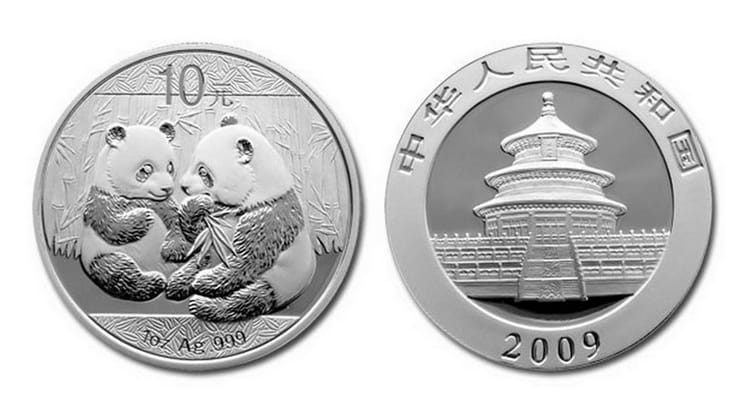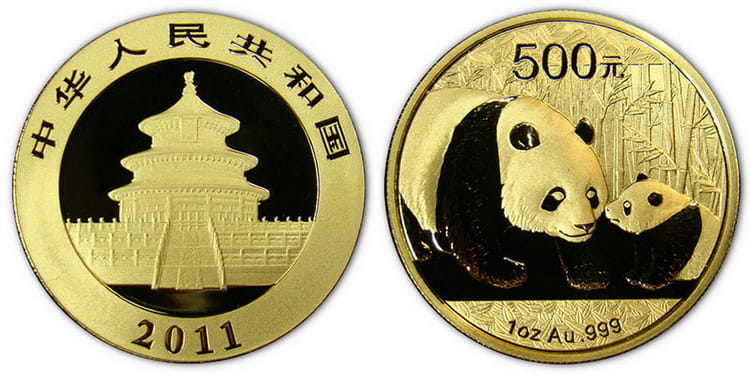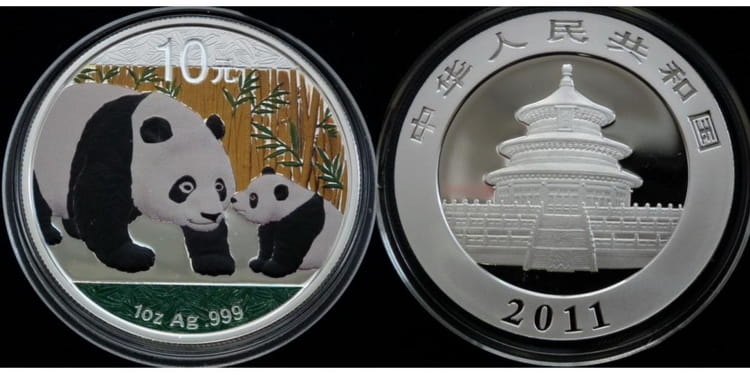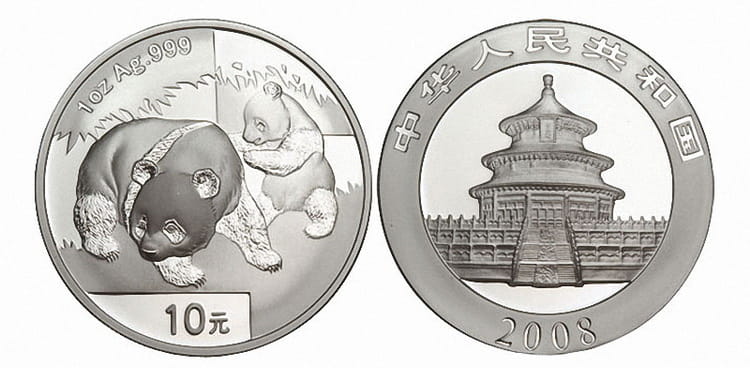
Chinese Silver Panda coins are part of the world famous collection of precious metal coins. From the first issues, they became popular with investors and collectors. This is evidenced by the high demand and the growing number of copies annually. Coins are profitable to purchase − high quality of coinage and from year to year the updated design provides them with investment returns and numismatic value. The most ancient samples are sold above their value (coins of 1983 are bought at a price of 4,000 $ USD with a denomination of 1,500 $ USD).
History
The first Chinese coins of the Panda series were minted of gold in 1982. Investors in precious metals praised the quality and design. In terms of popularity and beauty, investment samples did not yield to the world famous South African “Krugerrands”. The following year, the Central Bank of China issued silver “Pandas”. As in the case of the Canadian Maple Leaf, it became necessary to create a silver version to attract a large number of buyers who cannot invest in expensive precious metal but would like to purchase an investment coin.
Did you know? To determine the rarity of some coins from the Silver Panda series is quite difficult. This is due to the fact that the accuracy of the figures indicated by the Mint of China is not always correct. Often, parties of certain years were awarded contracts. Some of them, for some reason, were minted partially or not at all. Some samples were melted several years later. Thus, the actual amount of coins was less than that declared by the Mint. Experienced collectors believe that the most elusive are coins of 1995, 1998, 1999 and 2000.
Silver coins of the Panda series are minted in various sizes and denominations:
- 1983 − 1985 The weight of the test coinage was 27 grams of 900 samples and a diameter of 38.6 mm. Coins issued as a Proof with a circulation of 10,000 coins.
- 1986 − Panda coins of silver were not issued. Instead, a memorable edition dedicated to the Wildlife Fund was minted (the panda is depicted on the organization’s logo). Its denomination was 5 yuan, and weight − 22 grams.
- 1987 − For the first time, the Mint of China presents sterling silver “Panda” (925 sterling silver) to customers. The composition for coins is made from 92.5% silver and 7.5% copper. Both metals are mixed at very high temperatures (about 164 degrees Fahrenheit). Due to this, silver acquires extremely durable properties and the ability to maintain excellent appearance over a long period. “Panda” from sterling silver was minted only in 1987. Coin’s weight is 1 troy ounce, diameter −40 mm.
- 1988 − Silver coins of the Panda series were not minted.
- 1989-1997 at the Mints of China began to produce silver coins weighing 1 ounce, 999 samples and denominations of 10 yuan. For 8 years, only the design changed, the characteristics of the coin remained the same.
- 1997 − the first bimetallic investment coins appeared − samples of silver as a Proof with gold inserts. Circulation was 80 000 copies.
- 1998 − for the first time a silver “Panda” weighing 1 kilogram was released. The denomination of the coin is 300 yuan, the diameter is 100 mm.

In subsequent years, the Mint of China supported the issuance of silver coins of 10 yuan, 999 samples, weighing 1 troy ounce. The “Pandas” from this series were incredibly popular. In 1998, 200,000 pieces were minted, in 2010 − 1,500,000, from 2012 to 2015 − 8 000 000 pcs.
Design
Chinese silver “Panda” is considered one of the most sought coin. The main reasons for the popularity are the annually changing design of the front side and the unique properties of the metal. Silver makes it possible to artistically convey the features of the pattern — the white and black fur of the animal, the dark spots around the eyes.

The 1983 Panda was the first investment silver coin in the world with an annually changing design. The drawing is updated with each release (except for 2001-2002). The surface is decorated with an elegant portrait of a traditional bear − the national symbol of China and one of the rarest animals in the world. The image is easily associated with the People’s Republic of China, just as the eagle and bison from the USA, kangaro and kookabarra with Australia, forest wolf or grizzly bear with Canada. Their images are often minted on investment coins of each country.
Did you know? Early versions of silver coins (before 1989) as Proof and Brilliant Uncirculated were almost identical in design. Both options had a glossy gloss surface and a matte pattern. In order to distinguish between “Pandas”, the letter P was added to the obverse of the coin as a Proof. In 1993-1994 the design of the coins began to differ, but the mark remained the same. In 1995, this mark was removed.
Pandas on coins minted in different angles. In the early instances, one animal is depicted, in later versions, two and three bears. Pandas eat bamboo or hold it in their paws, drink water from the river, climb or hang on a tree branch. There are images of mom and cub, who simply sit or snuggle up to each other. Above the image is the denomination of the coin, at the bottom − the name of the metal, the sample and weight. On coins of 2015, there is only a face value.
Did you know? Depending on the year of production, some elements (coin value, sample) on the reverse side are swapped. The location depends on the design of the image and, as a rule, the placement of the animal in the picture.
Three Mint are engaged in the production of coins:
- 1983-1989 − only the Shanghai Mint
- 1990-1998 − Shanghai and Shenyang Mint
- 1999–2018 − Shanghai, Shenyang and Shenzhen
Unlike the US, Australian and Canadian Mint, China does not have a stamp, so it is impossible to determine the origin of the coin. Only in some years you can notice slight differences in the design of the back or the size of the date. The difference is especially noticeable on the 1999 “Pandas”.

The obverse depicts the Temple of Heaven − a cult Chinese landmark built between 1404-1420. The building is located in Beijing − in the south-east of the Imperial Palace. For the inhabitants of the country, this place is sacred, is the subject of pride and greatness of civilization. From 1983 to the present day, the design of an architectural monument has changed only slightly. The inscription in hieroglyphs − the name of the state and year of issue is minted.
Circulation
The first circulations of silver “Pandas” from 1983 to 1985. minted exclusively as a Proof in the amount of 10,000 pieces. The weight of the coin was 27 grams, the silver content was 24.3 g, the sample was 900, the diameter was 38.6 mm. In 1987, the circulation was increased to 31,000 coins as a Proof. The sample rose to 925, weight up to 31.1 grams. The diameter of the coin was increased to 40 mm and no longer changed this figure.
Did you know? All the most popular investment coins, such as “Philharmonic”, “Maple Leaf”, “American Eagle”, are measured in troy ounces (31.1034768 grams) . In China, this unit is not used. The first batches of silver coins “Panda” tried to measure according to European standards, but in 2016 it was decided to switch to the usual metric system − grams. Investment coins “Panda” with a par value of 10 yuan were issued in the most approximate figure − 30 grams.
In subsequent years, the bulk of the coins were “Pandas” as Brilliant Uncirculated. Silver coins as Proof minted in smaller quantities:
- 1989 − Uncirculated − 250,000, Proof − 25,000 pcs
- 1990 − Uncirculated − 200,000, Proof − 20,000 pcs
- 1991 − Uncirculated − 100,000 Proof − 20,000 pcs
- 1992 − Uncirculated − 100,000 Proof − 5,205 pcs
Since 1993, the number of coins issued as a Proof is not precisely known − this information is hidden from investors and collectors in order to create even more intrigue. The number of coins as Uncirculated for the entire period increased from 600,000 to 8,000,000.
Cost of coins
Silver Chinese coin “Panda” has an impressive growth potential. Its value determines the significant demand among collectors and the recognition of investors all over the world, as well as limited circulation. New coins are buying at 23 $ USD, and selling at 25 $ USD. Older samples cost between 300 and 4,000 $ USD.
Comments
No commens yet.